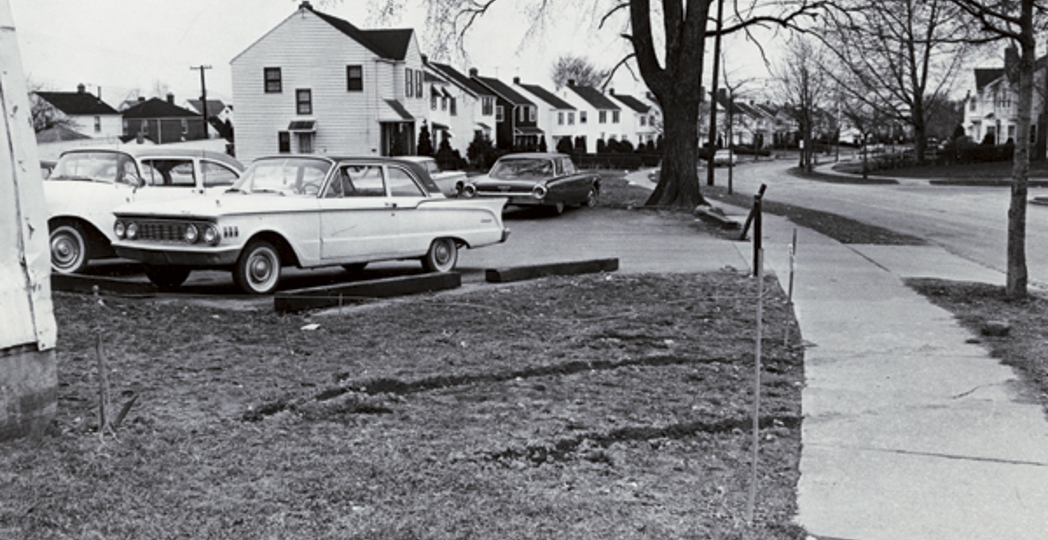Cleveland's Outer Neighborhoods Could Be The Key To The Future
by Todd Michney | Dec. 4, 2017 | 2:00 PM

Cleveland Public Library Photograph Collection
It’s how we’ve always done it.
Practically all past approaches to urban revitalization over the last century have meant passively watching migration out of the city — a trend complicated by the reality of race.
White people move from the city to the streetcar suburbs to the exurbs. They go from Millionaires’ Row to Glenville to the Heights to Bainbridge. They follow the Lake Erie shore from Detroit Shoreway to Lakewood to Rocky River to Avon Lake. African-Americans and other minorities follow.
As all move outward, they leave problems in their wake.
In Cleveland, reversing that pattern has meant a concentration of development attention on the glitzy prospects of downtown and the near West Side. If Northeast Ohio is a doughnut, the center city and its struggling neighborhoods such as Kinsman and Central are the hole. To try and fill that gap, the focus has been to harness downtown’s prosperity and fill from the core out. Eventually, the theory says, you’ll get a whole pastry.
But there is another path. I recently wrote Surrogate Suburbs: Black Upward Mobility and Neighborhood Change in Cleveland, 1900-1980. The title refers to outlying city neighborhoods such as Lee-Harvard — places where African-Americans successfully accessed suburban living at a time when the actual suburbs were effectively off limits.
Surrogate suburbs, an expanded definition of which could also include neighborhoods such as West Park, Old Brooklyn and North Collinwood, have some of the amenities and feel of the actual suburbs, but development there will not further the detrimental effects of sprawl.
These suburb-like neighborhoods have the broad appeal of relatively low housing costs and storied histories of hard work and hard knocks. They offer the possibility of more equitable development. So why not start with the outer edges of the doughnut and build in?
The center-out process of development often seems to coincide with continued residential segregation. As early as the turn of the century, small numbers of black families moved to Cleveland’s urban periphery. But by the 1920s, African-Americans were targeted by a new real estate market that defined them as “detrimental” to property values. Their white would-be neighbors sought to exclude them through deed restrictions and covenants, until outlawed by the U.S. Supreme Court in 1948. Black borrowers were denied bank loans on homes outside of established African-American settlements.
A few succeeded against the odds, such as Dr. Charles Garvin, who purchased in the Wade Park Allotment in 1925. His neighbors signed a legal agreement pledging not to sell other properties to racial minorities and dynamited his house twice. Yet he stayed put.
Meanwhile, black Southerners were migrating north for industrial jobs. The same exclusion concentrated them along Cedar Avenue, crowded into the oldest housing. To white observers, the rapid deterioration that followed, culminating in the Hough Riots, seemed to confirm their notions about poor African-American property stewardship.
Such a mentality was given the guise of officialdom by the federal government from the 1930s to 1950s. New Deal policymakers commissioned maps of more than 200 cities, including Cleveland. African-American neighborhoods were grouped with industrial land and “nuisances.” They were outlined in red and deemed unsuitable for investment, birthing a new term of art: redlining.
The Federal Housing Administration and, later, the Veterans Administration guaranteed generous loans, but only in racially homogeneous suburban subdivisions. Paired with the new interstate highway system, those lending practices became an “invisible” step stool for working-class whites. Millions took the bait, buying homes in the burbs.
We have heard much of this story before. But less well known are the creative strategies that middle-class African-Americans in Cleveland’s surrogate suburbs used to successfully navigate the numerous barriers placed in their way. We can learn from their determination and their neighborhoods.
They purchased undeveloped land ahead of race-based restrictions or enlisted sympathetic whites to sign over properties. They built houses themselves or relied on African-American contractors. They borrowed from black-owned companies. They pressured city officials to enforce their rights as taxpayers. Some even used risky land contracts that built no equity until paid in full.
Take the case of Henry Hawk, a truck driver turned construction worker. Like many of his neighbors, Hawk and his wife purchased a lot on East 162nd Street off Lee Road soon after World War II, then built their brick bungalow with their own hands.
“I made mine the hard way,” he said at a 1953 meeting. Other nearby black residents even dug and installed their own sewer lines. Finally, some were so determined that they willingly overpaid for houses brought onto the market through blockbusting.
In this way, Lee-Harvard during the 1950s became a surrogate suburb. Black middle-class homeowners framed a near-comprehensive reform agenda there, seeking to improve infrastructure and traffic safety, maintain city services, reduce liquor availability and preempt crime.
Their work endures. Lee-Harvard still has strong bones, Ward 1 Councilman Terrell Pruitt told me in October. Its housing is affordable and in good shape. There are ample parks and intact commercial corridors. Most importantly, the neighborhood boasts an ongoing tradition of civic-minded engagement.
Some homeowners have maintained their properties for 40 years. Recently, with the assistance of the Cleveland Restoration Society, residents are seeking historic landmark designation for a subdivision of 1950s homes built by an African-American developer.
It’s less costly to shore up an already intact neighborhood, Pruitt points out, with a quicker return on the public investment. “People moved out here in droves in the 1950s and ’60s because they were attracted to the affordable living, quality homes and neighborhoods designed around family life, and access to school facilities,” he notes.
In formulating a balanced strategy to revitalize Cleveland, we would do well to recognize surrogate suburbs. Lee-Harvard, according to the Western Reserve Land Conservancy’s 2015 citywide property inventory, is on the lower end of city neighborhoods in terms of vacant properties, with roughly 5 percent vacant. In that survey, Lee-Harvard even falls in the same category as Ohio City, with only between 1.1 and 3 percent of all structures graded D or F. And in the November election, in which Pruitt was unseated, Wards 1 and 17 — Lee-Harvard and West Park — had the highest voter turnout in the city. That is historical strength, living today.
“The key is trying to reinvent what worked in the past,” Pruitt observes. “The same thing that attracted people 50 years ago is still here today. It’s authentic, not a facsimile of something but something that’s always existed.”
While West Park, Old Brooklyn, North Collinwood and Lee-Harvard have varied racial histories and have not fully recovered from the 2008 housing crisis, they could be a more equitable next step in Cleveland’s development arc. Surrogate suburbs could help build back toward a downtown that’s beginning to prosper.
Instead of spreading out, as we’ve always done, why not work in?
Trending
-
1
-
2
-
3
-
4
-
5










